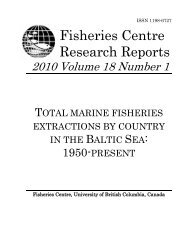report - Sea Around Us Project
report - Sea Around Us Project
report - Sea Around Us Project
Create successful ePaper yourself
Turn your PDF publications into a flip-book with our unique Google optimized e-Paper software.
68 Fisheries catch reconstructions: Islands, Part II. Harper and Zeller<br />
that for the early 1950s, population statistics were underestimated by as much as 60% (Underwood, 1989)<br />
and in the most recent decade, the population was overestimated by 20% to 40%, due to the rapidly<br />
increasing emigration of foreign NPC workers (Vunisea et al., 2008). Hence it is noteworthy to mention<br />
that the per capita fish consumption of 56 kg∙person 1∙year -1 <strong>report</strong>ed by Bell et al. (2009), which we used<br />
for recent time periods, is likely underestimated, due to it being based on inflated population estimates.<br />
Despite the economic surge provided by the island’s phosphate earnings during earlier decades, Nauru’s<br />
fisheries did not develop in similar fashion, due in part to the absence of natural harbours to moor vessels.<br />
Three man-made channels and a small boat harbour have been excavated through the coral fringing reef,<br />
allowing only small outboard powered vessels to be launched. Industrial-scale fishing was attempted in<br />
the early 1980s involving two purse-seine vessels, but was not successful due to ineffective gear and<br />
through market loss which led to the sale of one vessel while the other was lost at sea (Chapman, 1998).<br />
Nauru has been a party to the US Multilateral Fisheries Treaty since it came into effect in June 1988. In<br />
July of 1994, Nauru entered into a bilateral fishing access agreement with Japan, granting four Japanese<br />
fishing vessels access to Nauruan waters and in June 1997, the first fishing access agreement was signed<br />
with the Philippines (Chapman, 1998). It is estimated that Nauru received about US$3.4 million in access<br />
fees in 1999 (Gillett and Lightfoot, 2002) and US$5.4 million in access fees in 2008 (Gillett, 2009), with<br />
131 foreign fishing vessels (10 countries), licensed to fish in Nauru’s EEZ, catching approximately 66,000<br />
t of tuna.<br />
Attempts to farm milkfish (Chanos chanos) and tilapia (Oreochromis mossambicus) in the past had<br />
failed; these fish were introduced into the Baduan Lagoon. Milkfish, although part of the traditional<br />
Nauruan diet and culture, were used as bait for tuna fishing (Spennemann, 2002). Tilapia was introduced<br />
in the early 1960s but was not accepted as a staple food option and eventually infested all the milkfish<br />
ponds causing many farmers to abandon their traditional practice of raising milkfish (Gillett, 2009).<br />
Programs to eradicate the introduced fish from the island’s lagoon have failed (Dalzell et al., 1996). In<br />
2000, 10,000 milkfish fry from Kiribati were introduced into Buada Lagoon, reaping 5,000 adult fish<br />
(Gillett, 2009). At present, several milkfish grow-out ponds exist; these are backyard and mostly<br />
subsistence operations. No accurate production estimates exist (Gillett, 2009).<br />
Inshore fishing pressure appears to have increased dramatically since the late 1990s, with almost all<br />
households involved in fishing; women and children glean the beaches and reefs, collecting all<br />
invertebrate and finfish species they come across. Vunisea et al. (2008) surveyed invertebrate catches,<br />
estimating the total catch to be 23 t·year -1, dominated by genera such as Etisus, Octopus, Turbo, Thais,<br />
Tripneustes and Cardisoma and to a lesser extent Actinopyga, Panulirus, Grapsus, and Cypraea. All<br />
species and types are targeted and consumed, with the exception of lobsters, which are destined for sale<br />
(Vunisea et al., 2008). All sizes of fish are caught and consumed, however fishers have observed a<br />
decrease in size and volume of catches (Vunisea et al., 2008), suggesting that overfishing is occurring.<br />
There has been a steady increase in the intensity and frequency of fishing since the economic crisis in<br />
1999, driven mainly by increasing subsistence efforts. Presently, pelagic fishing is dominated by canoes<br />
operated by Tuvaluans and I-Kiribati (Vunisea et al., 2008).<br />
Fish continue to form a large part of the Nauruan diet, increasingly so with the island’s recent economic<br />
downturn. Food security may be jeopardized, leading to substantial dietary changes. Imported produce<br />
such as meat and poultry have been replaced with canned sardines and mackerel from abroad, seafood<br />
provides the main source of protein for more than 98% of Nauruan households (Vunisea et al., 2008).<br />
The Nauru Fisheries and Marine Resource Authority (NFMRA) have the responsibility of overseeing,<br />
managing and conserving the country’s natural marine resources and environment. Yet, with fishing<br />
being the only major fallback option for the population, the task presents several challenges, especially<br />
when marine resources are vulnerable to overexploitation and the livelihoods of an entire nation are at<br />
risk.





![Nacion.com, San José, Costa Rica [Nacionales] - Sea Around Us ...](https://img.yumpu.com/26166123/1/190x245/nacioncom-san-josac-costa-rica-nacionales-sea-around-us-.jpg?quality=85)










